PONTIAC GRAND-AM 1993 Owners Manual
Manufacturer: PONTIAC, Model Year: 1993, Model line: GRAND-AM, Model: PONTIAC GRAND-AM 1993Pages: 306, PDF Size: 15.39 MB
Page 241 of 306
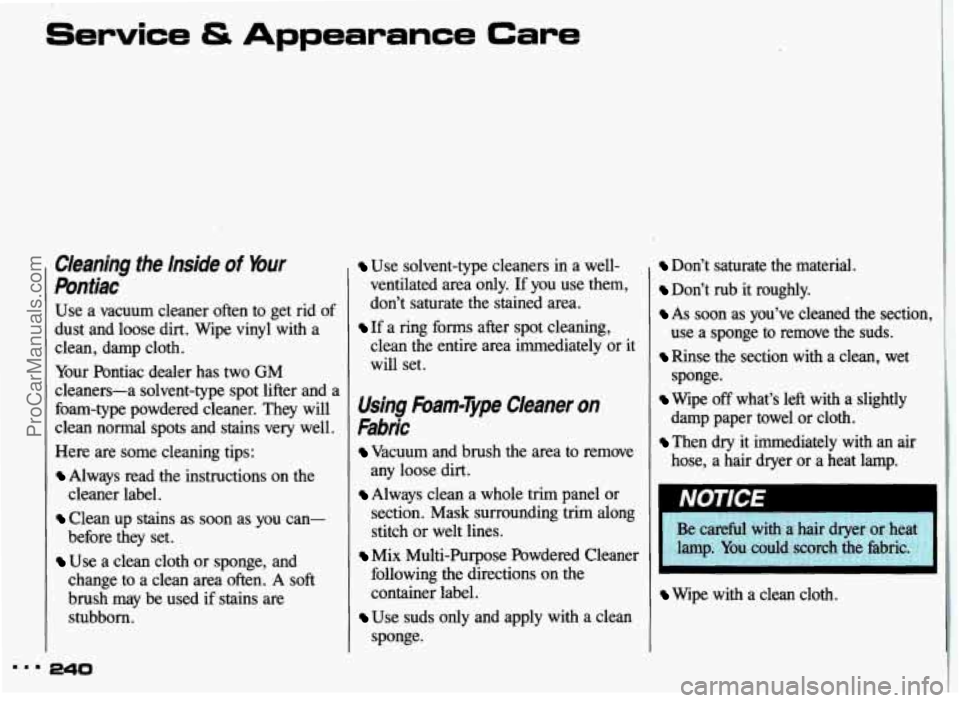
Service & Appearance Care
Cleaning the Inside of Your
Pontiac
Use a vacuum cleaner often to get rid of
dust and loose dirt. Wipe vinyl with a
clean, damp cloth.
Your Pontiac dealer has two GM
cleaners-a solvent-type spot lifter and a
foam-type powdered cleaner. They will
clean normal spots and stains very well.
Here are some cleaning tips:
Always read the instructions on the
cleaner label.
Clean up stains as soon as you can-
before they set.
Use a clean cloth or sponge, and
change to a clean area often. A soft
brush may be used if stains are
stubborn.
Use solvent-type cleaners in a well-
ventilated area only. If you use them,
don’t saturate the stained area.
clean the entire area immediately or it
will set.
If a ring forms after spot cleaning,
Using Barn-Type Cleaner on
Fabric
Vacuum and brush the area to remove
Always clean a whole trim panel or
any
loose dirt.
section. Mask surrounding trim along
stitch or welt lines.
Mix Multi-Purpose Powdered Cleaner
following the directions on the
container label.
Use suds only and apply with a clean
sponge.
Don’t saturate the material.
Don’t rub it roughly.
As soon as you’ve cleaned the section,
use a sponge to remove the suds.
Rinse the section with a clean, wet
sponge.
Wipe off what’s left with a slightly
damp paper towel or cloth.
Then dry it immediately with an air
hose, a hair dryer or a heat lamp.
I NOTICE
I I
Be
careful with a hair dryer or heat
lamp. You could scorch
the fabric.
Wipe with a clean cloth.
ProCarManuals.com
Page 242 of 306
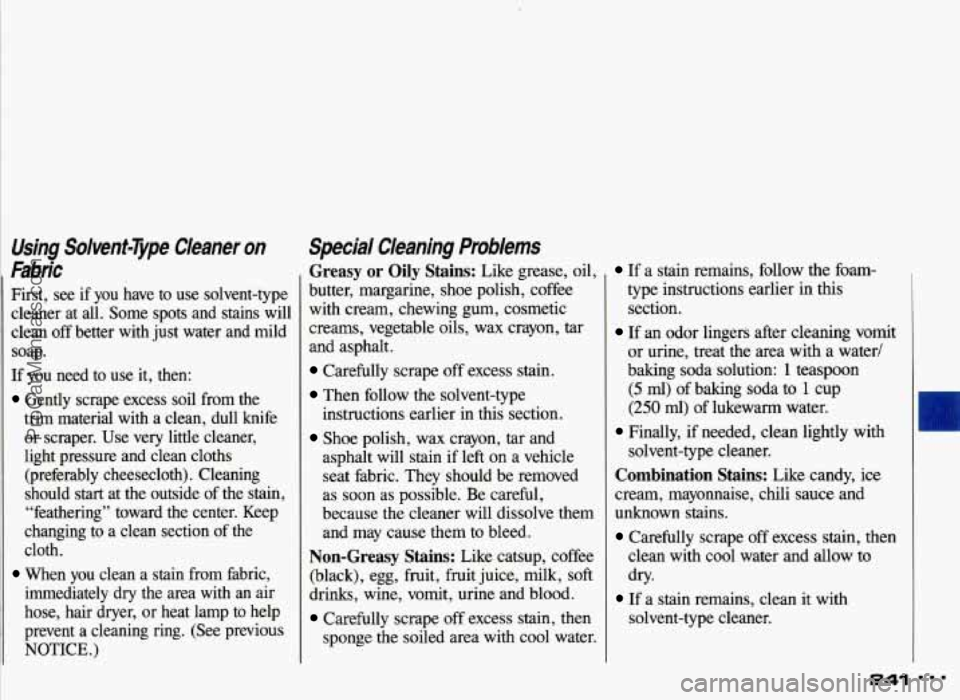
Using Solvent-7jvpe Cleaner on
Fabric
First, see if you have to use solvent-type
cleaner at all. Some
spots and stains will
clean off better with just water and mild
soap.
If you need to use it, then:
Gently scrape excess soil from the
trim material with a clean, dull knife
or scraper. Use very little cleaner,
light pressure and clean cloths (preferably cheesecloth). Cleaning
should start at the outside of the stain,
“feathering” toward the center. Keep
changing to a clean section of the
cloth.
When you clean a stain from fabric,
immediately dry the area with an air
hose, hair dryer, or heat lamp to help
prevent a cleaning ring. (See previous
NOTICE.)
Special Cleaning Problems
Greasy or Oily Stains: Like grease, oil,
butter, margarine, shoe polish, coffee
with cream, chewing gum, cosmetic
creams, vegetable oils, wax crayon, tar
and asphalt.
Carefully scrape off excess stain.
Then follow the solvent-type
Shoe polish, wax crayon, tar and
instructions
earlier in this section.
asphalt will stain if left on a vehicle
seat fabric. They should be removed
as soon as possible. Be careful,
because the cleaner will dissolve them
and may cause them to bleed.
Non-Greasy Stains: Like catsup, coffee
(black), egg, fruit, fruit juice, milk,
soft
drinks, wine, vomit, urine and blood.
Carefully scrape off excess stain, then
sponge the soiled area with cool water.
If a stain remains, follow the foam-
type instructions earlier in this
section.
If an odor lingers after cleaning vomit
or urine, treat the area with a water/
baking soda solution:
1 teaspoon
(5 ml) of baking soda to 1 cup
(250 ml) of lukewarm water.
solvent-type cleaner.
Finally, if needed, clean lightly with
Combination Stains: Like candy, ice
cream, mayonnaise, chili sauce and
unknown stains.
Carefully scrape off excess stain, then
clean with cool water
and allow to
dry-
If a stain remains, clean it with
solvent-type cleaner.
241
ProCarManuals.com
Page 243 of 306
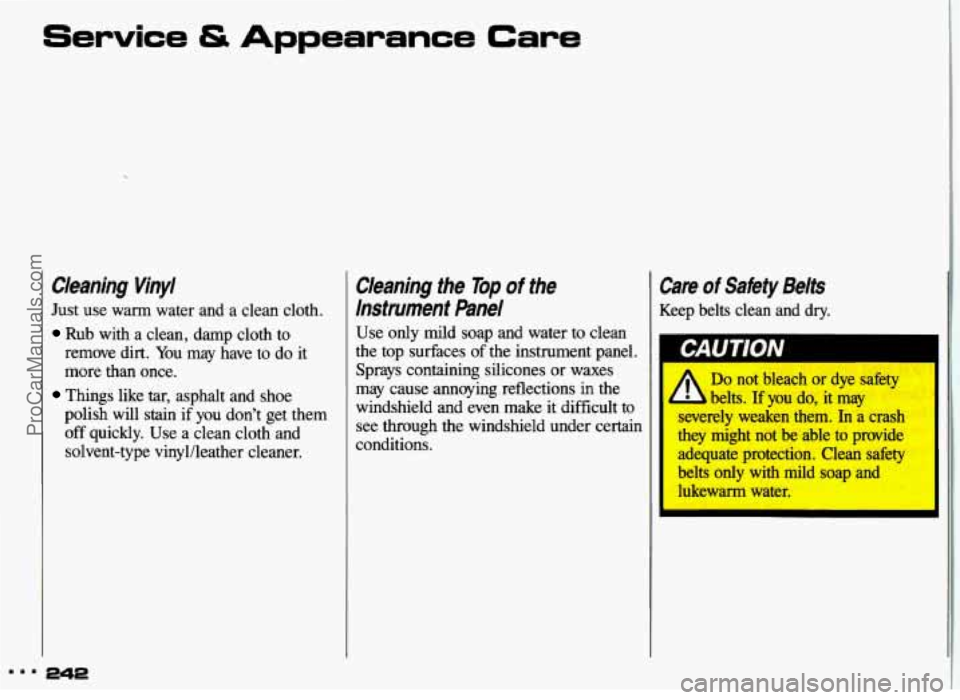
888
Service Appearance Care
Cleanjng Vinyl
Just use warm water and a clean cloth.
Rub with a clean, damp cloth to
remove dirt. You may have to do it
more than once.
polish
will stain if you don’t get them
off quickly. Use a clean cloth and
solvent-type vinyl/leather cleaner.
Things like tar, asphalt and shoe
Cleaning the Top of the
Instrument Panel
Use only mild soap and water to clean
the top surfaces of
the instrument panel.
Sprays containing silicones or waxes
may cause annoying reflections
in the
windshield and even make it difficult to
see through the windshield under certain
conditions.
;art? of Safety Belts
leep belts clean and dry.
Do not bleach or dye safe
belts. If you do, it may
severely weaken them.
In a crash
they might not be able to provide
adequate protection. Clean safety
belts only with mild soap and
lukewarm water.
ProCarManuals.com
Page 244 of 306
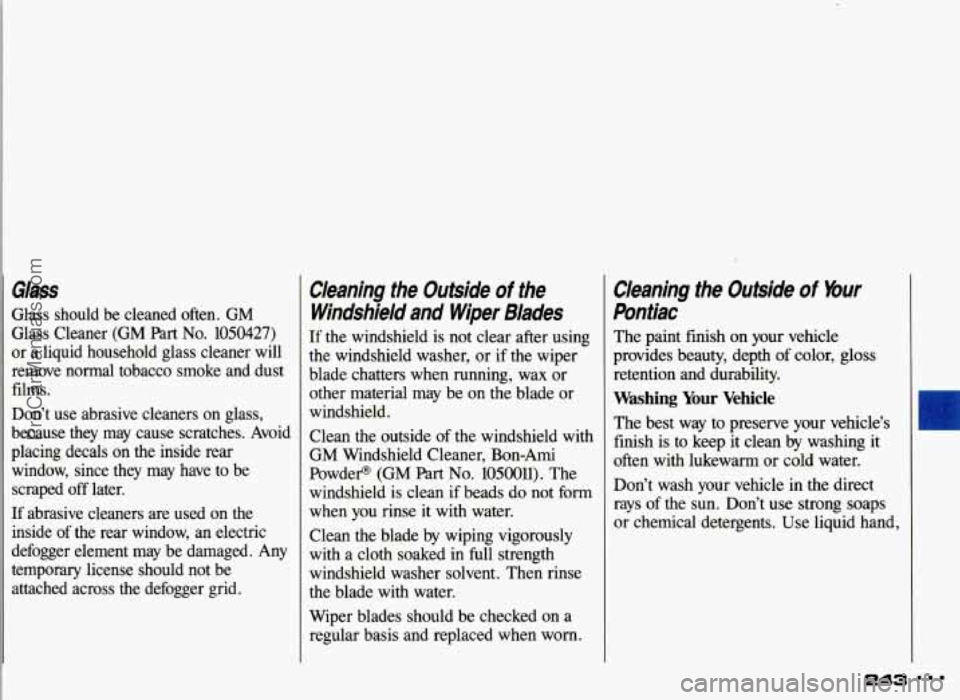
Glass
Glass should be cleaned often. GM
Glass Cleaner (GM
Part No. 1050427)
or a liquid household glass cleaner will
remove normal tobacco smoke and dust films.
Don’t use abrasive cleaners on glass,
because they may cause scratches. Avoid
placing decals on the inside rear
window, since they may have to be
scraped
off later.
If abrasive cleaners are used on the
inside
of the rear window, an electric
defogger element may be damaged. Any
temporary license should not
be
attached across the defogger grid.
Cleaning the Outside of the
Windshield and Wiper Blades
If the windshield is not clear after using
the windshield washer, or if the wiper
blade chatters when running, wax or
other material may be on the blade or
windshield.
Clean the outside
of the windshield with
GM Windshield Cleaner, Bon-Ami
Powder@ (GM
Part No. 1050011). The
windshield is clean if beads
do not form
when you rinse it with water.
Clean the blade by wiping vigorously
with a cloth soaked in full strength
windshield washer solvent. Then rinse
the blade with water.
Wiper blades should be checked on a
regular basis and replaced when worn.
Cleaning the Outside of bur
Pontiac
The paint finish on your vehicle
provides beauty, depth
of color, gloss
retention and durability.
Washing Your Vehicle
The best way to preserve your vehicle’s I
finish is to keep it clean by washing it
often with lukewarm or cold water.
Don’t wash your vehicle in the direct
rays of the sun. Don’t use strong soaps
or chemical detergents. Use liquid hand,
243
ProCarManuals.com
Page 245 of 306
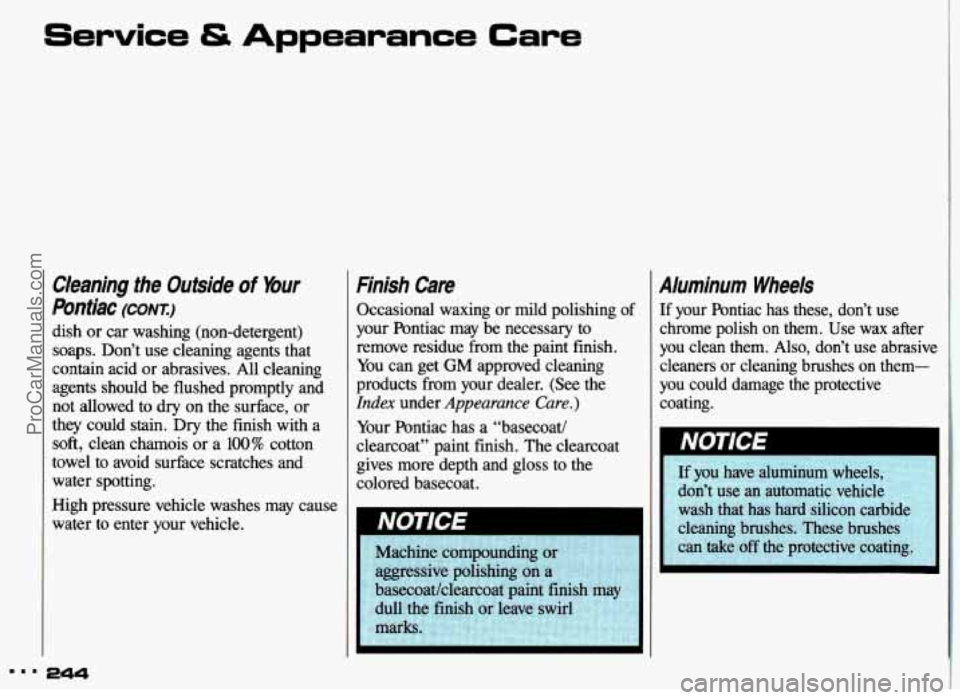
Service & Appearance Care
Cleaning the Outside of Your
pbntiac (CONT)
dish or car washing (non-detergent)
soaps. Don’t use cleaning agents that
contain acid or abrasives. All cleaning
agents should be flushed promptly and
not allowed to dry on the surface, or
they could
stain. Dry the finish with a
soft, clean chamois or a 100% cotton
towel to avoid surface scratches and water spotting.
High pressure vehicle washes may cause
water to enter your vehicle.
244
Finish Care
Occasional waxing or mild polishing of
your Pontiac may be necessary to
remove residue from the paint finish.
You can get
GM approved cleaning
products from your dealer. (See the
Ida under Appearance Care.)
Your Pontiac has a “basecoat/
clearcoat” paint finish. The clearcoat
gives more depth and gloss to the
colored basecoat.
Aluminum Wheels
If your Pontiac has these, don’t use
chrome polish on them. Use wax after
you clean them.
Also, don’t use abrasive
cleaners or cleaning brushes on them-
you could damage the protective
coating.
ProCarManuals.com
Page 246 of 306
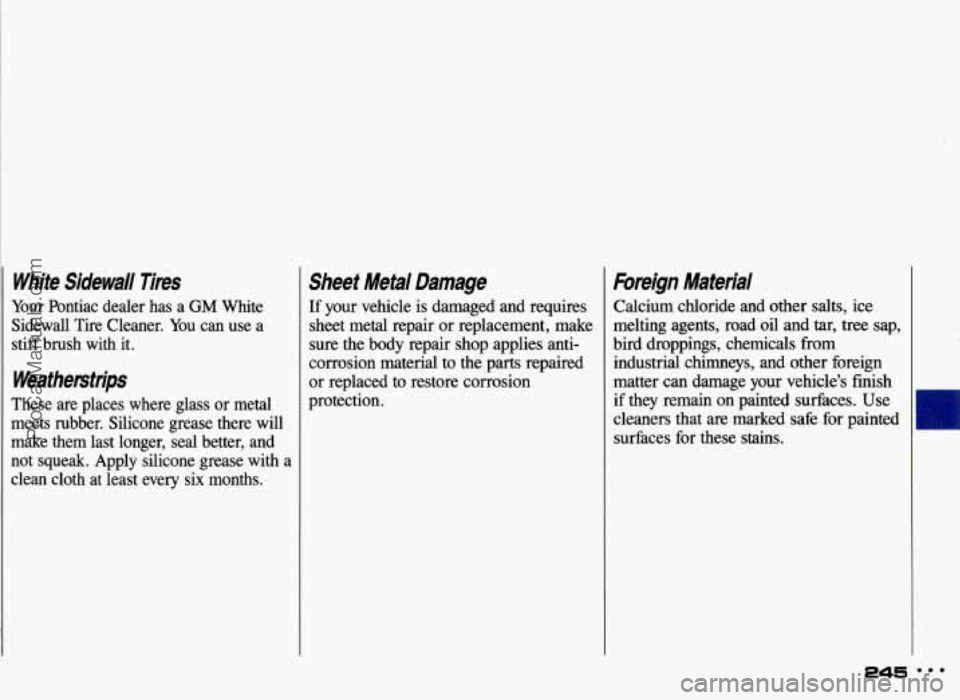
White Sidewall Tines
Your Pontiac dealer has a GM White
Sidewall Tire Cleaner.
You can use a
stiff brush with it.
Weatherstrips
These are places where glass or metal
meets rubber. Silicone grease there will
make them last longer, seal better, and
not squeak. Apply silicone grease with a
clean cloth at least every six months.
Sheet Metal Damage
If your vehicle is damaged and requires
sheet metal repair or replacement,
make
sure the body repair shop applies anti-
corrosion material to the parts repaired
or replaced to restore corrosion
protection.
Fbreign Material
Calcium chloride and other salts, ice
melting agents, road
oil and tar, tree sap,
bird droppings, chemicals from
industrial chimneys, and other foreign
matter can damage
your vehicle’s finish
if they remain on painted surfaces. Use
cleaners that are
marked safe for painted
surfaces for these
stains.
845
ProCarManuals.com
Page 247 of 306
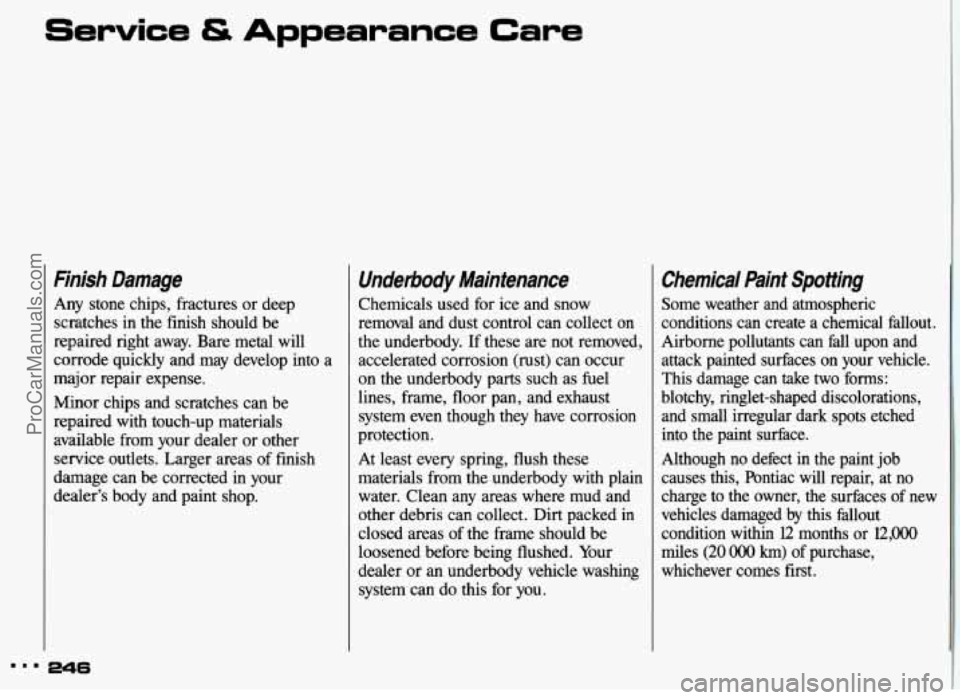
Finish Damage
Any stone chips, fractures or deep
scratches in the finish should be
repaired right away. Bare metal will
corrode quickly and may develop into a
major repair expense,
Minor chips and scratches can be
repaired with touch-up materials
available from your dealer or other
service outlets. Larger areas of finish
darnage can be corrected
in your
dealer’s body and paint shop.
Underbody Maintenance
Chemicals used for ice and snow
removal and dust control can collect on
the underbody. If these are not removed,
accelerated corrosion (rust) can occur
on the underbody parts such as fuel
lines, frame, floor pan, and exhaust system even though they have corrosion
protection.
At least every spring, flush these
materials from the underbody with plain
water. Clean any areas where mud and other debris can collect. Dirt packed in
closed areas of the frame should be
loosened before being flushed. Your
dealer or
an underbody vehicle washing
system can do this for you.
Chemical Paint Spotting
Some weather and atmospheric
conditions can create a chemical fallout.
Airborne pollutants can fall upon and
attack painted surfaces on your vehicle.
This damage can take two forms:
blotchy, ringlet-shaped discolorations,
and small irregular dark spots etched into the paint surfhce.
Although no defect in the paint job
causes this, Pontiac will repair, at no
charge to the owner, the surfaces of new
vehicles damaged
by this fallout
condition within
l2 months or l2,OOO
miles (20 OOO km) of purchase,
whichever comes first.
ProCarManuals.com
Page 248 of 306
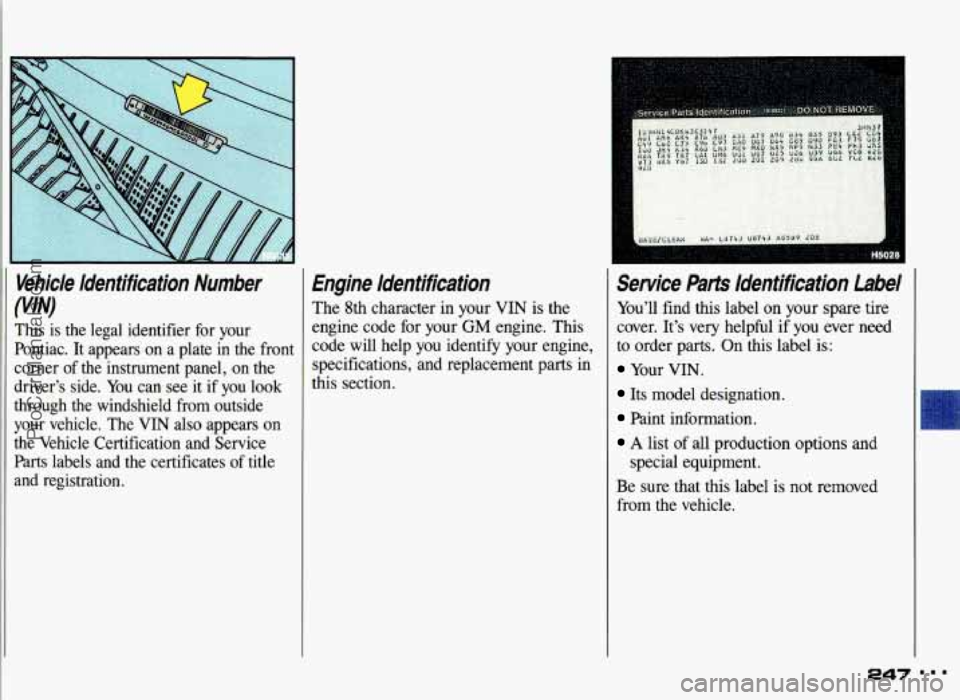
(VlN) Vehicle Identification Number
This
is the legal identifier for your
Pontiac. It appears on a plate in the front
corner of the instrument panel,
on the
driver's side. You can see it if you look
through the windshield from outside
your vehicle. The
VIN also appears on
the Vehicle Certification and Service
Parts labels and the certificates of title
and registration.
Engine Identification
The 8th character in your VIN is the
engine code for your
GM engine. This
code will help you identify your engine,
specifications, and replacement parts in
this section.
Service Parts Identification Label
You'll find this label on your spare tire
cover. It's very helpful if you ever need
to order parts. On this label is:
Your VIN.
Its model designation.
Paint information.
A list of all production options and
special equipment.
Be sure that this label is not removed
from the vehicle.
E47
I
...
m
ProCarManuals.com
Page 249 of 306

Service & Appearance Care
Add-on Electrical Equbment Fuses & Circuit Breakers
The wiring circuits in your vehicle are
protected from short circuits by a
combination of fuses and circuit
breakers.
The main fuse panel is located on the
left side
of the instrument panel. To
access the fuses, open the fuse panel
door,
Look at the silver-colored band inside
the fuse.
If the band is broken or
melted, replace the fuse. Be sure you
replace
a bad fuse with a new one of the
correct
size.
ProCarManuals.com
Page 250 of 306
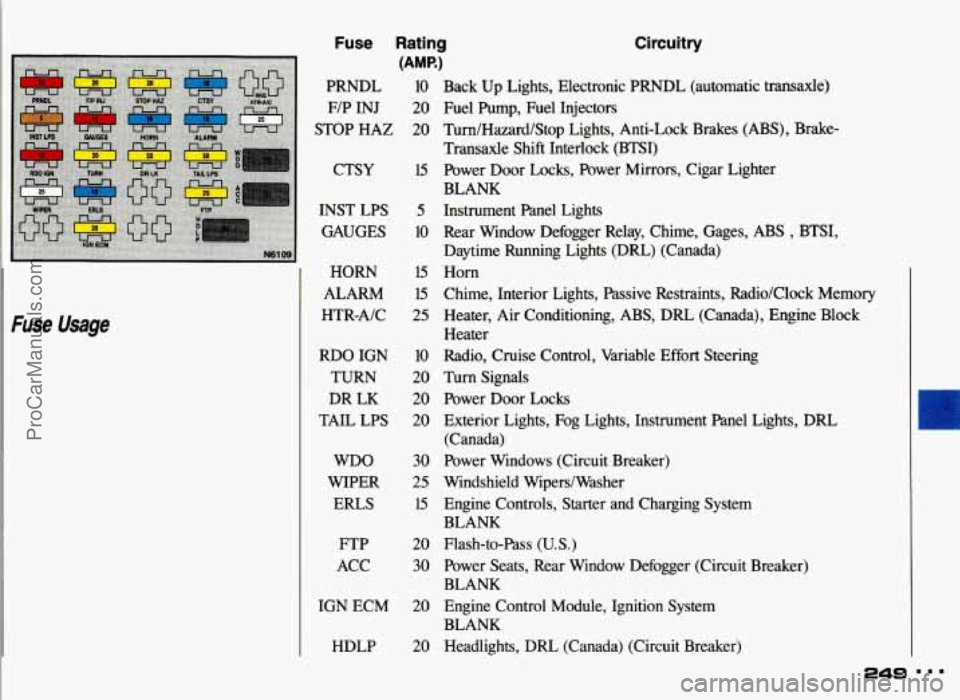
Fuse Rating Circuitry
Fuse Usage
HORN
ALARM
HTR-A/C
RDO IGN
TURN
DR LK
TAIL LPS
WDO
WIPER ERLS
FTP
ACC
IGN ECM
HDLP
15
15
25
10
20
20
20
30
25
15
20
30
20
20
Back Up Lights, Electronic PRNDL (automatic transaxle)
Fuel Pump, Fuel Injectors
Turn/Hazard/Stop Lights, Anti-Lock Brakes
(ABS), Brake-
Transaxle Shift Interlock
(BTSI)
Power Door Locks, Power Mirrors, Cigar Lighter
BLANK
Instrument Panel Lights
Rear Window Defogger Relay, Chime, Gages,
ABS , BTSI,
Daytime
Running Lights (Dm) (Canada)
Horn
Chime, Interior Lights, Passive Restraints, Radio/Clock Memory
Heater, Air Conditioning, ABS, DRL (Canada), Engine Block
Heater
Radio, Cruise Control, Variable
Effort Steering
Turn Signals
Power Door Locks
Exterior Lights, Fog Lights, Instrument Panel Lights, DRL
(Canada)
Power Windows (Circuit Breaker)
Windshield WipedWasher
Engine Controls, Starter and Charging System
BLANK
Flash-to-Pass
(US.)
Power Seats, Rear Window Defogger (Circuit Breaker)
BLANK
Engine Control Module, Ignition System
BLANK
Headlights, DRL (Canada) (Circuit Breaker)
ProCarManuals.com